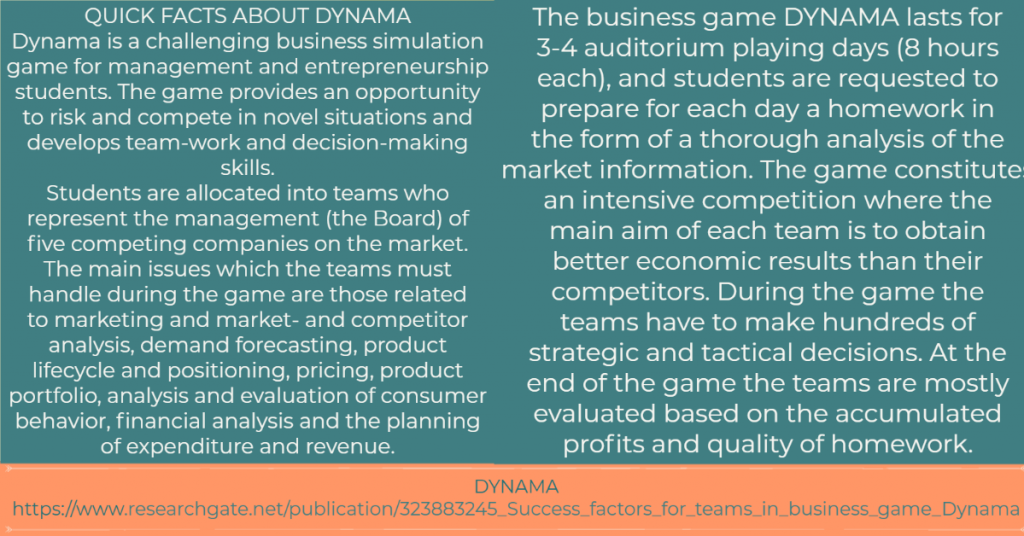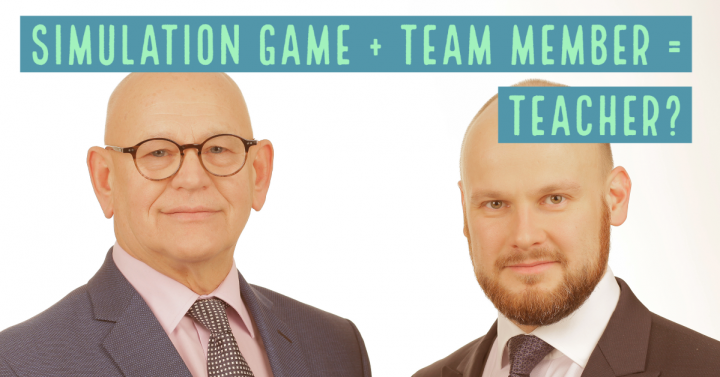
A university has been and will be a safe place and I am not speaking about being a ‘clean’ environment in the classical sense. Today’s university is a ‘safe place to fail’ as it provides students with opportunities to practice something, that one cannot learn simply by studying a book. The business game Dynama is based on long-term research into consumer behavior and has been created by professor Alf-Eric Lerviks at Hanken School of Economics and Business Administration. The design of the game, the teaching methodology and materials have been developed by Anto Liivat and Peeter Kross who have taught the game for the past 10 years at Estonian Business School. As through simulation games both, the students and teachers, learn, today’s triple-interview presents both perspectives: The students’ perspective is represented by an MBA candidate Kristel Vaher, while the representatives of teachers’ voices are Peeter Kross (Associate Professor) and Anto Liivat (Head of Bachelor’s studies) at Estonian Business School.
How does simulation-based learning differ from traditional learning in an academic setting?
KRISTEL: In a traditional lecture, you as a student are more or less alone – you listen, get some tasks and after some time submit homework as a solution to the task. There is quite a long-time span between teacher teaching and student using the information (or in positive cases, the knowledge). In simulation games, one gets the instant feedback – first, whether you actually have understood things correctly and then, if you are able to put this knowledge into practice. In the case of team tasks (that forms the basis of Dynama), you constantly experience how differently people interpret the same kind of information. Thus, learning happens on many levels.
In Dynama, all the subjects are tied together. You get the chance to use all your skills. These tasks are really awesome. In real life you are responsible for some stages/aspects of the “full business cycle”, but within the game you play through the full cycle. To do this, you need a very profound analysis and the ability to dig really deep into data. Without doing this you cannot understand the connections – what affects what? By the end, you understand all these connections.
PEETER: Well, as Dynama takes the form of an intense teamwork, then by nature everybody learns, also these students whose level of knowledge, in the beginning, is not on an equal basis with the rest of the team members. Learning inside the team, from team member to team member works very well. Nevertheless, it is important to stress that I, as a lecturer, also learn each time from teaching the simulations. I thought at my age it is not possible to surprise me, but it happens again and again! As a result, we have constantly developed the game throughout the 10 years.
What has been the most important learning outcome for you when learning or teaching based on a simulation game?
KRISTEL: You get a real sense of how things work in reality. Thus, the „true charm“ of a simulation game is that it prepares you for a real sense of how things work practically. In Dynama we had teams without any assigned leaders. Thus, a group of students came together and had to work together. In real life, it’s basically the same – some of us know something, the others the other things. How to work together and achieve a common goal? In some of the teams, there were some activists, who volunteered to lead the team and most probably teams that have an initiator like that, are more successful.
PEETER: Within the course all teams provide us with 50-60 pages of homework altogether based on data analysis to cope with the business challenges companies are facing throughout the game. Also, students research in real-life enterprises to study the best practices which could be applied in the game. These works are written in a very limited time period, but as a result of deep focus, are often more insightful than classical research papers of students.
How to overcome the challenges of teamwork during intense simulation games?
KRISTEL: In an MBA program, these students who cannot contribute due to a variety of reasons feel bad about it, thus do not do it intentionally. This is because we all feel that team effort depends on each individual effort. After understanding this, teamwork is not a challenge, but a safe and quick way to try out what works and what does not.
PEETER: As team work during Dynama can get intense, we assigned to each team of BA students a leader who was expected to take the responsibility. But now we do not do it anymore, in order to let them decide on their own on the team responsibilities within the teams and experience the natural flow of team dynamics. Thus, teams are expected to decide how they are managed – we want them to face the consequences of different types of decisions. All in all, teams seem to work in a self-organizing way well and it happens very seldom that teams break out.
ANTO: It is natural, that some students contribute more and some less. We just assume that everybody does as much and as well as they are able to and in case nobody complains, all team members are graded on equal basis. Peer-pressure tends to work well and as a result of this, more is learned. Also emotions play an important role in the development of leadership competences and this is the reason why we have very precisely thought through how we develop the emotions and group dynamics throughout the course. Thus, we come up with some challenges at the moment when they begin to enjoy stability, similarly to what happens commonly in the business world. As in this game, Peeter and me are taking the roles of the board members, we are in a situation where we have to trust our staff. Thus, we intervene only when things go really wrong (what happens seldom) as we want them to adapt to the constantly changing environment.

How to prepare for a simulation game?
KRISTEL: Well, the whole life and MBA studies are like a preparation for this game when you are expected to use all your skills, knowledge, and experiences. Even these students who did not previously know that profit is not “the money you have in your bank account” know it now 😉 Thus, the best suggestion would be to be attentive, cooperative and keep the focus on the challenges and cooperation.
ANTO: Well, we do not want to see students to prepare for the game, we want the game to prepare them for their career! Therefore, we also want students to try out things they normally don’t dare to at the workplace. We let them fail fast and land soft. This gives us the chance to explain to them why things went wrong and what needs to be done differently to avoid similar mistakes from happening again. Based on the students’ feedback, the game experience also boosts students’ self-confidence. This is to happen most probably as we always end up with positive emotions and feelings of success.

My final question is targeted to teachers only. You mentioned that your course is always tailor-made. How is this arranged?
PEETER: We as teachers prepare for each simulation differently, thus the previous knowledge of the people belonging to particular study groups and the curriculum they have followed, needs to be taken into account. We pay special attention to the learning outcomes of each subject that the students have followed. Thus, what we aim to do is to build a net of the knowledge gained from other teachers. We expect our simulations to train most of all, the cognitions. Teamwork is important, but the most important is the content – the specific interdisciplinary management challenges that the students need to solve. To list some of them: corporate and product strategy, product portfolio management, presentation of annual results, corporate transactions (M&A), business valuation, market and competition analysis, income statement, balance sheet – as all this is crucial for top manager-to-be to understand and forms the core of the managerial job! Thus, what we do is to develop their professional cretinism by inviting them to observe challenges through the point-of-view of the board member. In the beginning of their career, this is the only time they can literally do that.
ANTO: We build different layers for each game, sometimes the game is more technical, sometimes scientific or practical. The biggest benefit for us with all these variations is that we gather data that helps us to create future stories, tasks and challenges. It is essential to have an appropriate level of challenge. Our courses need to be tailor-made also because we teach both – BA and MA students and cannot expect from them a similar kind of contribution. From Bachelor students we expect at least some basic forecast, while the MA students need to be able to create narratives to maximize the value of the company. We have been criticized for using the same game for Bachelor and MBA students. However, that is not an issue when you adopt the teaching methods and challenges based on the target group. Also, the rules for BA and MBA students are the same, but the game itself is often far different! Thus, quite the same rules apply for playing ice hockey in college leagues or in NHL.

By Marge Sassi, Flow Enthusiast and FLIGBY lecturer at Estonian Business School.

Comment by Dr. Zoltan Buzady, Academic Director of the ‘Leadership & Flow Global Research Network’: Dear Reader, You might also wish to read more about ‘Success factors for teams in business game DYNAM’ on Researchgate.net



